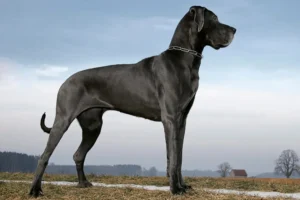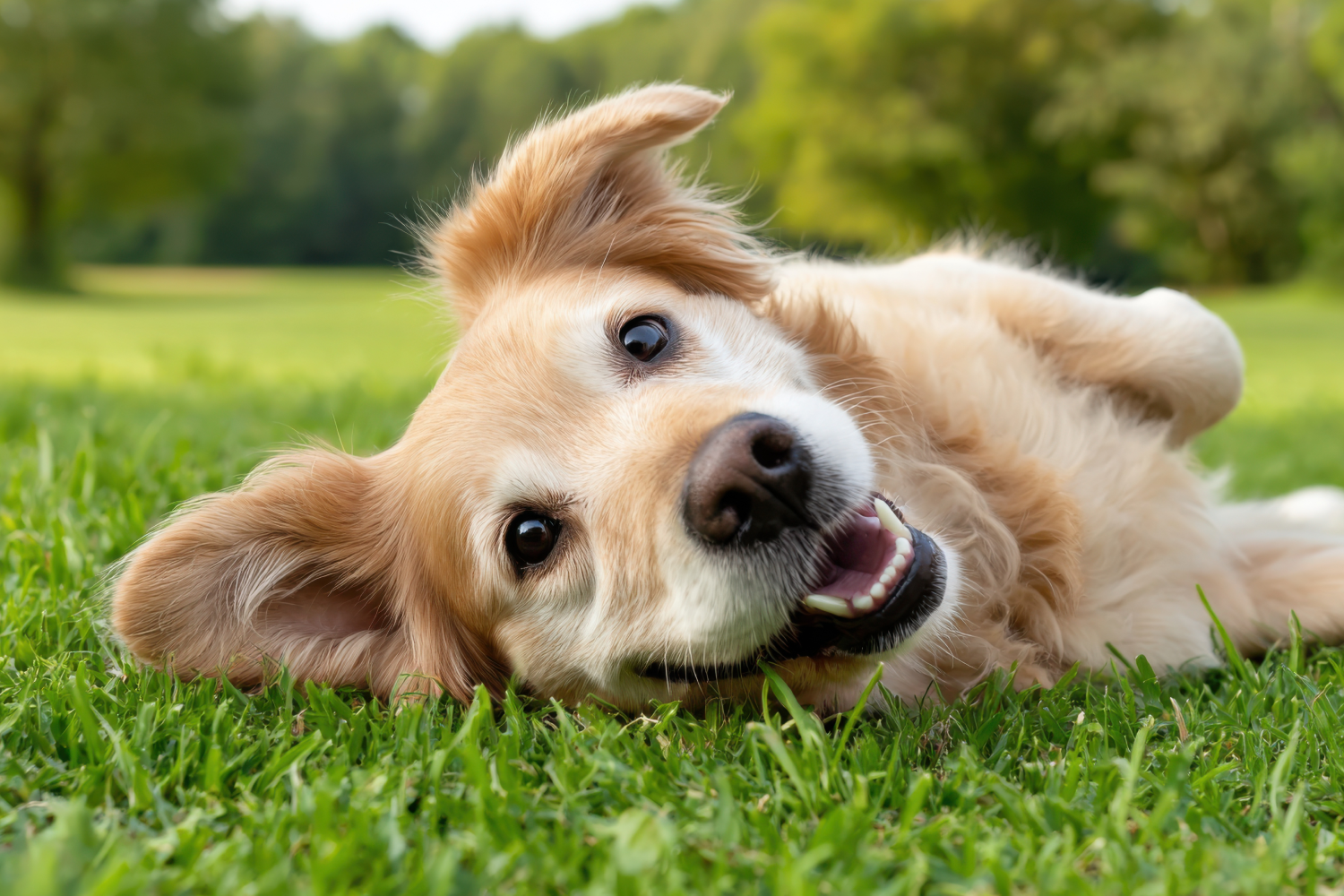
BOGO: buy a box of Longevity15 and get Yummy Combs free!
Shop now and get the BOGO deal today!
Joseph Roetheli, PhD

Highlights:
You might see your dog’s behavior as strange, but your dog is doing what it instinctively does to communicate with other animals.
Rolling in the grass is not usually a problem unless your dog develops allergies or becomes fixated on the behavior.
Understanding how your dog’s behavior communicates their needs can help you become a proactive pet owner.
Sometimes, your dog engages in funny behavior. For instance, who doesn’t giggle when they see their dog chase their tail or wriggle on the carpet to scratch their back?
Like these activities, dogs often roll around in the grass when they are outside. This may make you smile or cringe, depending on what’s in the grass that is being rolled in! For some dogs, rolling in the grass is a normal activity that simply communicates their presence to other dogs and animals in the area. For others, it’s a means of scratching an itch.
Most of the time, grass-rolling isn’t dangerous for your dog, although it might mean an additional bath is in the near future. If you notice your dog is consistently rolling in the grass, there could be an underlying cause.
We’ll explain the reasons why dogs roll in the grass and give you tips on what to do if your dog’s grass-rolling habits are becoming problematic.
Yes, there’s a legitimate and purposeful reason why your dog is rolling in that spot in the grass. Surprisingly, it isn’t always because they’ve found a “smelly spot” with which they want to perform themselves.
Dogs roll around for several reasons.
Even though your eight-pound miniature dachshund barks at the smallest noises and gets easily frightened, they have evolved from mighty hunting dogs. In the wild, rolling around in a spot that had the scent of another animal could have been used to cover up the dog’s scent, making it easier for them to hunt prey without being detected.
Even though your dog isn’t hunting prey, those same instincts are hard-wired in their DNA, so rolling in a spot that smells distinctively not like them is a natural behavior.
Dogs have methods of communication with one another and other animals that involve the use of scents. You may have noticed your dog “communicating” with other animals while on their walk if they stop every few yards to urinate.
This is your dog’s way of letting other animals know they were there. Rolling in the grass also allows your dog to leave a trace of their scent that other animals can pick up. Your dog may roll in the grass around the edges of your yard or in a spot they frequently use to potty to delineate that space as their own.
Dogs lack opposable thumbs, and many breeds lack lengthy limbs to scratch their backs. As such, the options for back scratches are limited. Rolling in the grass could be your dog’s clever way of scratching an itch they simply cannot reach on their own.
Sometimes, our best efforts to explain dog behavior fail because the reality is that there’s no explanation other than that our dogs like being dogs and doing dog things. If your dog occasionally rolls in the grass, they may do it simply because they enjoy it.
It feels good, they love being outdoors, and rolling in the grass makes them happy. Unless it is causing them harm or making it difficult to keep them clean, let them roll.
If your dog’s grass rolling seems to be happening more frequently, it could be an indication something is not right. For instance, dogs that roll in the grass instead of walking during a regular walk or that roll in the grass continually when let outdoors may have an underlying issue that needs to be treated.
Most of the time, your dog’s grass rolling is normal and natural. However, when it begins to interfere with their life or yours, there could be something triggering their rolling.
Skin allergies can be common in dogs. If your dog has an allergy, their skin may become dry and itchy, prompting them to mine every available resource to scratch their backs and bellies, including rolling in the grass.
Unfortunately, if your dog’s allergies include grass, they’ll be making matters worse. The only way to know for sure if your dog has an allergy to grass or anything else is to talk to their veterinarian.
There are numerous options available for controlling allergies and soothing dry, irritated skin. Allergy medications, shots, and shampoos can reduce the itchiness and help your dog find relief without rolling in the grass.
Dogs get bored just like humans. If your dog isn’t getting enough daily stimulation, they may resort to unwanted behaviors to fill their time.
Chasing their tails, chewing on items you’d rather them not chew on, and rolling around in the grass may be ways that your dog is communicating to you that they need a little extra activity. If you are already walking your dog regularly, try adding in an additional walk during the day or a few minutes of playtime to see if that will reduce the rolling.
You can also offer your dog treats inside of puzzle-style toys or mats that help keep them engaged in an activity while attempting to get the treat.
It’s unlikely you’ll be able to completely prevent your dog from rolling in the grass, but you may be able to reduce the frequency with which you see this behavior. Grass rolling can be difficult, particularly if your dog prefers to roll in the grass previously used by another animal to relieve themselves.
If your dog’s rolling is driving you nuts, there are a few solutions to try.
Dogs that have undesirable behavior issues may benefit from professional training. A professional trainer can work with your dog to help break them of the rolling habit and give you some solid tips on how to use positive reinforcement to encourage another behavior instead.
If you discover that your dog has allergies, take action to get them the relief they need through medication or other remedies. Likewise, if boredom is the issue, adding in extra playtime is a necessary first step before addressing the rolling itself.
It’s unlikely you’ll be able to completely break your dog’s grass-rolling habit. It’s a natural instinct for many dogs, and allowing them to engage in it is important. If you want to have a bit more control over what they roll in and when, try giving your dog unlimited access to roll in a particular area.
For instance, through training, reinforce your dog’s ability to roll when allowed in your backyard, but deter them from rolling around in spaces when you are on a walk. Using simple commands like “roll” or “no roll” can be effective in communicating to your dog when it is okay for them to roll and when it isn’t.
Another key component of positive reinforcement is offering a treat when your dog performs a desired behavior. When offering treats as part of your dog’s training, it’s important to remember you’ll need to reduce their kibble intake to account for the calories in the treats.
In order to do this safely, you’ll need to make sure the treats you offer are nutrient-dense so that your dog doesn’t end up with dietary gaps.
One solution? Yummy Combs®.
Treats are an essential way we bond with our dogs and help encourage positive behavior. When we give our dogs treats, we need to make sure they’re not only nutritious but safe.
Some treats easily become choking hazards and others are filled with empty calories that don’t support your dog’s needs. Yummy Combs treats are both safe and nutritious and have the bonus of helping support your dog’s oral health.
Giving your dog a treat that checks all the boxes just got a lot easier. Yummy Combs provide the essentials your dog needs and a flavor they’ll love.
Your dog loves to roll in the grass. Most of the time, it isn’t a problem. When it becomes an issue, you can take steps to help them break the habit. Using Yummy Combs as a reward is a great way to help reinforce positive behavior and improve your dog’s oral care at home.
Sources:
Why Do Dogs Roll in the Grass? | PetMD
Study links skin allergies in dogs to problem behaviors | American Veterinary Medical Association
Updates, coupons, deals, and more!
Type anything...
We use cookies to provide you the best possible experience on our website. You consent to the usage of cookies by continuing to view our website. See our Privacy Notice for more information.